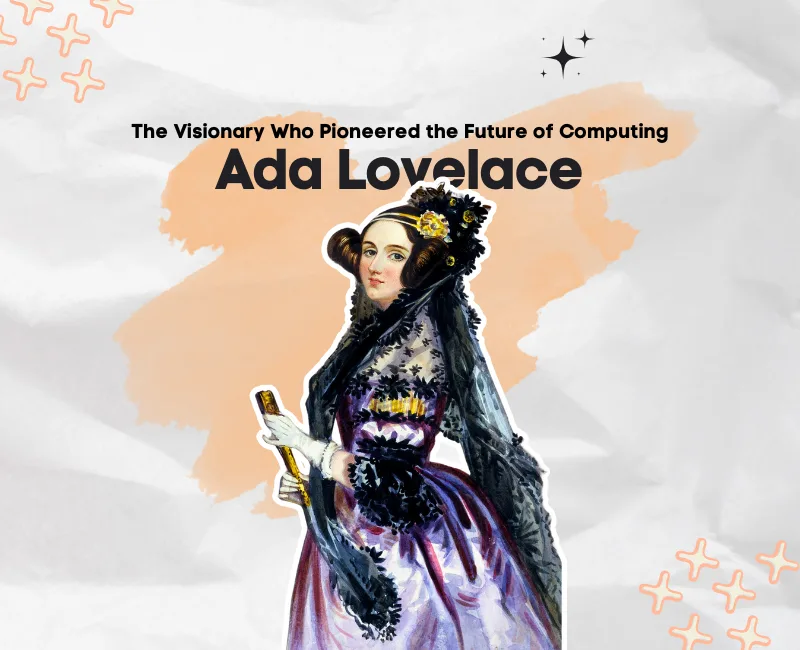Ada Lovelace: The Visionary Who Pioneered the Future of Computing

Ada Lovelace is a name that connotes intelligence and inventiveness. Her work created the groundwork for contemporary computing, and she is frequently credited as the first computer programmer. In addition to her innovative contributions, her life is an inspiring story of overcoming societal barriers to leave a lasting legacy in mathematics and technology.
This article details Ada Lovelace’s life, partnership with Charles Babbage, accomplishments, and lasting influence on society and technology.
About Ada Lovelace
Augusta Ada King, Countess of Lovelace (Dec 10, 1815 – Nov 27, 1852), widely known as Ada Lovelace, was an English mathematician and writer celebrated for her groundbreaking work on Charles Babbage’s Analytical Engine, a precursor to a general-purpose computer. Ada is often credited as the first computer programmer to recognize the machine’s potential beyond basic calculations and create the first algorithm for a mechanical computer.
Ada was the only legitimate child of the famed poet Lord Byron and reformer Anne Isabella Milbanke. Her parents’ marriage was brief, and Lord Byron left England forever shortly after her birth. He passed away when Ada was eight, yet she retained a deep curiosity about him, naming her sons Byron and Gordon and requesting to be buried beside him.
Her mother, determined to distance Ada from her father’s reputed instability, emphasized a rigorous education in mathematics and logic. This foundation nurtured Ada’s intellect despite her frequent illnesses as a child. She married William King in 1835, who later became the Earl of Lovelace, giving her the title of Countess of Lovelace.
Ada’s intellectual pursuits introduced her to influential figures like Charles Babbage, Andrew Crosse, Michael Faraday, and Charles Dickens. Her collaboration with Babbage began in 1833, leading to her most notable achievement—translating and expanding Luigi Menabrea’s paper on the Analytical Engine in 1842. Her notes, particularly the seventh, included a detailed algorithm, earning her a place in computing history.
Ada’s unique perspective, called “poetical science,” allowed her to envision the machine’s ability to process more than numbers, seeing it as a tool for broader human creativity. Ada’s modern programming language is named in her honor, commemorating her visionary contributions.
Early Life of Lady Ada Lovelace
Ada Lovelace’s childhood was marked by privilege and isolation. Born into a tumultuous family, she experienced her parents’ early separation.
Her parents’ turbulent marriage ended shortly after her birth, with her mother leaving their home when Ada was just five weeks old. Despite the laws of the time giving fathers custody of children, Lord Byron did not attempt to claim Ada and left England permanently. He passed away in 1824 when Ada was eight years old, leaving her with no personal memories of him.
Raised by her mother, who was determined to distance Ada from her father’s perceived “poetic madness,” Ada received a strict and rigorous education focused on mathematics and science—uncommon fields of study for women in the 19th century. Her mother ensured Ada was surrounded by tutors and intellectual mentors, laying the foundation for her future achievements.
Despite these efforts, Ada’s relationship with her mother was distant and strained. Her upbringing was often overseen by her maternal grandmother, who adored her. However, Ada was closely monitored by Lady Byron’s network of friends, whom Ada mockingly referred to as “the Furies.”
As a child, Ada showed remarkable imagination and curiosity. At age twelve, she embarked on an ambitious project to design a flying machine, carefully studying the anatomy of birds and experimenting with various materials for wings. She documented her findings in a book called Flyology and even considered using steam power to enhance her designs.
Frequent illnesses also marked Ada’s early years. At eight, she began suffering from severe headaches that impaired her vision. In 1829, she contracted measles, which left her temporarily paralyzed and bedridden for nearly a year. By 1831, she had recovered enough to walk with crutches, and despite these challenges, she continued to cultivate her passion for mathematics and technology.
Ada’s determination, intellect, and boundless curiosity were evident from a young age, setting the stage for her groundbreaking contributions to the computing world.
Adult Years and Personal Life
Ada Lovelace’s adult years were a mix of societal prominence, intellectual pursuits, and personal challenges. At 17, she became a regular at social events, admired for her intelligence and charm. Despite this, her relationship with her father’s friends was strained due to her mother’s influence. Over time, she overcame some of these initial tensions, notably befriending John Hobhouse, a close companion of her father.
In 1835, Ada married William King, the 8th Baron King, becoming Lady King. The couple had three children: Byron, Annabella, & Ralph. They lived in several homes, including Horsley Towers, a grand estate designed with Ada’s creative input. In 1838, her husband was elevated to Earl of Lovelace, granting Ada the title Countess of Lovelace.
While raising her family, Ada maintained her intellectual connections, forming friendships with prominent scientists and writers like Mary Somerville, Charles Dickens, and Michael Faraday. However, her life also saw moments of turmoil. In the 1840s, she became embroiled in gambling scandals, losing significant sums and attempting to create a mathematical model for betting, which ultimately failed.
Ada’s relationships also stirred controversy. She faced rumors of extramarital affairs and had a complicated bond with John Crosse, the son of scientist Andrew Crosse. Despite these challenges, her resilience and intellect shone through.
Ada’s final years were marked by illness and introspection. Her dedication to her family, mathematical pursuits, and enduring legacy as a pioneer in computing remain the most defining aspects of her remarkable life.
Education Of Lady Ada Lovelace
Ada Lovelace’s education was unconventional and rigorous, setting her apart from many women of her time.
From a young age, Ada displayed an insatiable curiosity and a talent for analytical thinking. Recognizing this, her mother hired top tutors to nurture her abilities. One of her most influential mentors was Mary Somerville, a renowned mathematician and scientist who later became a close friend. Somerville guided Ada in her studies and introduced her to key figures in the scientific community, including Charles Babbage, the inventor of the Difference Engine.
Ada’s education focused on logic and abstract reasoning. She delved into subjects such as algebra, geometry, and calculus, developing a sophisticated understanding rare for women of her era. Her ability to synthesize complex concepts laid the groundwork for her later contributions to computing.
Despite the structured nature of her education, Ada’s imagination often intertwined with her studies. She referred to her approach to mathematics as “poetical science,” believing that creativity and logic were deeply interconnected. This unique perspective allowed her to see possibilities beyond the calculations, a trait that would later define her collaboration with Charles Babbage.
Ada Lovelace and Charles Babbage: A Historic Partnership
The meeting between Ada Lovelace and Charles Babbage in 1833 marked the beginning of a partnership that would change the course of technological history. Introduced by Mary Somerville, Ada was captivated by Babbage’s work on the Difference Engine, a mechanical calculator designed to perform complex mathematical operations.
Babbage was equally impressed by Ada’s intellect and innovative thinking. Their discussions soon went beyond the workings of the Difference Engine, delving into Babbage’s conceptual design for a more advanced machine: the Analytical Engine. Unlike the Difference Engine, which was limited to specific calculations, the Analytical Engine was envisioned as a programmable general-purpose computing machine—a revolutionary concept for the time.
Ada’s role in this partnership peaked in 1842–1843 when she translated a paper by the Italian mathematician Luigi Federico Menabrea on the Analytical Engine. More than a mere translation, Ada expanded the paper with her notes, which tripled its length. These notes included what is now considered the first algorithm intended for a machine—a set of instructions to calculate Bernoulli numbers. This remarkable work earned Ada the “first computer programmer.”
Her notes also revealed her visionary understanding of the Analytical Engine’s potential. She recognized that it could process numbers and any data represented symbolically, such as music or text. This insight was far ahead of her time and demonstrated her ability to think beyond the machine’s immediate capabilities.
Ada and Babbage’s collaboration was a meeting of two brilliant minds. While Babbage conceptualized the hardware, Ada envisioned its broader implications, laying the foundation for modern computing. Though the Analytical Engine was never fully built during their lifetimes, Ada’s contributions remain a testament to her pioneering intellect and imaginative foresight.
The First Computer Programmer
Ada Lovelace is often celebrated as the first computer programmer, a title she earned not simply because she wrote the first algorithm but also because of her visionary understanding of what computers could become. Her work laid the foundational principles of programming, influencing the very fabric of the computing world centuries later.
Ada’s insights were transformative for several reasons. She was the first to recognize that a machine could manipulate symbols rather than just numbers. In its ideal form, she understood that the Analytical Engine could serve as a tool not merely for performing tasks but also for creating things—ideas, patterns, and even art. This conceptual leap is why Ada Lovelace is often described as having a visionary understanding of computing.
In her notes, Ada speculated that the machine could be programmed to produce music or art. This idea was not realized in her lifetime but would later be the foundation for many modern developments in computing.
Her ability to think beyond numbers and understand the machine’s potential as a multi-purpose tool makes her the first computer programmer and one of the first to conceptualize the broader scope of computer science as it exists today.
Challenges and Triumphs Ada Lovelace Faced
Despite her achievements, Ada faced significant societal barriers. In the Victorian era, women were seldom encouraged to pursue intellectual endeavors, let alone in fields like mathematics and engineering. Ada’s success is a testament to her determination and intellect.
Despite facing these barriers, Ada worked alongside men like Charles Babbage, advocating for her ideas in a male-dominated field. She fought for recognition for the Analytical Engine, which was dismissed by many as a “theoretical exercise.” Her resilience in overcoming these obstacles has made her an enduring symbol of innovation.
Challenges and Triumphs Ada Lovelace Faced
Ada Lovelace Day, observed annually on the second Tuesday in October, commemorates women in science, technology, engineering, and mathematics (STEM). This global event recognizes Ada’s history as a trailblazer and promotes gender equality in STEM disciplines.
The day encourages young girls to pursue careers in science, technology, engineering, and mathematics, celebrating Ada’s achievements and those of other women who’ve paved the way.
The day also sparks meaningful conversations about diversity and inclusivity in these fields, helping to create more opportunities for women in STEM and ensuring Ada’s legacy continues to inspire future generations.
Ada Lovelace Death
Ada Lovelace passed away at the age of 36 on November 27, 1852, due to uterine cancer. Her illness lasted for several months, during which her mother, Annabella, took control of her care, limiting her contact with friends and confidants.
Under her mother’s influence, Ada underwent a religious transformation and was persuaded to repent for her past actions, making Annabella her executor. Ada lost contact with her husband after confessing something to him on August 30, which led him to leave her side.
The details of their conversation remain unknown. As per her wishes, Ada was buried beside her dad at the Church of St. Mary Magdalene in Hucknall of Nottinghamshire.
Conclusion
Ada Lovelace’s life and work inspire anyone who dares to dream large and challenge the current quo. Technology has evolved due to her vision of computing as a potent tool for advancement and creativity, and her legacy keeps us motivated to invent and envision a better future.
Ada Lovelace’s contributions to computing teach us about the origins of computer programming and the importance of vision, perseverance, and creativity in changing the world.
As we advance in the digital age, we can draw inspiration from Ada to think creatively, push the boundaries of technology, & create a more inclusive and innovative future.


